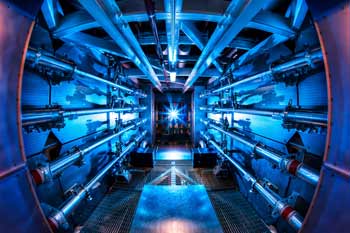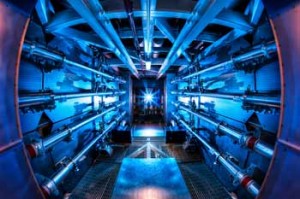
Laser Fusion Hits Milestone
 Two weeks ago, the National Ignition Facility (NIF) achieved a milestone on the journey to commercializing fusion energy. On July 5, NIF, which is housed within the Lawrence Livermore National Laboratory (LLNL), used lasers to deliver a record amount of energy to its target. Using 192 lasers (each of which would be the world’s largest alone), NIF shot a record 500 terrawatts (TW) of energy, more than the total amount of energy used in the United States at any moment in time.
Two weeks ago, the National Ignition Facility (NIF) achieved a milestone on the journey to commercializing fusion energy. On July 5, NIF, which is housed within the Lawrence Livermore National Laboratory (LLNL), used lasers to deliver a record amount of energy to its target. Using 192 lasers (each of which would be the world’s largest alone), NIF shot a record 500 terrawatts (TW) of energy, more than the total amount of energy used in the United States at any moment in time.
The laser shot brings the scientific community one step closer to realizing fusion energy. With fusion, two hydrogen isotopes are collided together (not to be confused with the more well-known nuclear fission, which splits atoms apart). When two hydrogen isotopes collide together and fuse, a large volume of energy is produced. It is the same process that powers the sun.
But, how is fusion done in practice? There are two main approaches currently being done in labs around the world. NIF is using the approach known as “inertial confinement fusion”. (The other approach is known is “magnetic fusion”, which you can read about here). With inertial confinement fusion, lasers are used to heat the fuel pellet which is a mixture of two hydrogen isotopes – deuterium and tritium. Once the lasers shoot enough energy into the fuel pellet, it heats up 100 million degrees and the isotopes fuse together, releasing energy. NIF hopes that the lasers can reach “ignition,” whereby a self-sustaining burn creates more energy than is put in.
When fusion is commercialized, it will provide enormous benefits. The two key ingredients – deuterium, which comes from ocean water, and tritium, which can be produced from lithium – are relatively common. Enough resources exist for centuries, largely solving our energy supply concerns. Also, no greenhouse gases or other pollutants are emitted from fusion, producing only clean energy. Unlike fission, there is no runaway chain reaction, so a Fukushima-style meltdown would not be possible.
Research on fusion energy, with robust funding, will not only lay the groundwork for future commercialization, but also supports a world-class scientific workforce that produces side benefits – innovations in materials science, robotics, and supercomputing, among others.
Much work remains to be done to commercialize fusion energy, but in the near-term, the next step for NIF is to achieve “ignition” – the point at which the plasma fusion burn releases more energy than is put in. A spokesman from NIF commented in the wake of their record laser shot, saying they are “tantalizingly close” to achieving a net gain in energy production from “ignition”. They believe they are “75% of the way there,” and expect “ignition” in the next 6-18 months.
ASP has been following the progress of fusion energy closely, and in the coming weeks will highlight the importance of adequate funding for fusion.





